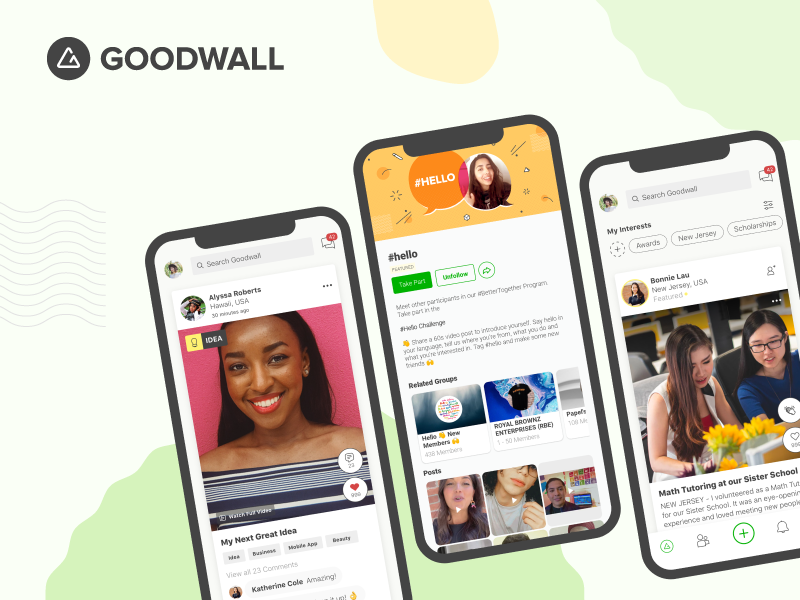Writing a resume can be quite an intimidating task, and that’s just one part of the overall job search process.
But—what to include in a resume?
In this guide, we’ll walk you through the most crucial resume sections to include, from the core parts of a resume (numbers 1–5) through to other important areas you might want to add, depending on their relevance to your situation.
So, let’s get started, shall we?

Want to showcase yourself in the best way possible to future employers or universities? Sign up to Goodwall!
- Develop skills & experience
- Highlight accomplishments
- Network globally
- Find top jobs & internships
Download the app now to get started!
Here are all the sections to include on a resume:
1. Contact Information
At the very top of your resume, you’ll start with your contact information.
In the past, it would have been simply your name, address, and phone number. These days, however, there are a lot more details to include in your resume contact info section, and the address isn’t so relevant.
Here’s which personal details to include:
- Your full name
- Current title or branding statement (optional)
- Email address
- Phone number
- LinkedIn profile URL
- Links to professional profile or website
The most important thing to remember, whether in the contact details area or any other resume sections, is to maintain relevance. Meaning, if it is helpful to you getting the interview and for the hiring manager to assess you, include it. Otherwise, leave it off.
Related Read: 55 Resume Tips, Hacks & Expert Advice to Help You Score a Job Interview
2. Resume Summary or Objective
Just below your personal information section comes the resume objective or summary, a short paragraph statement meant to include the juiciest points of the document like a mini elevator pitch.
They’re both essentially the same thing, though used for slightly different scenarios. If you have past work experience relevant to the job you’re applying for, use the resume summary to sum it all up. Otherwise, use the resume objective statement to identify your goals and how they align with the company’s mission and needs.
3. Work History Section
The first five parts of a resume on this list are core sections to include, but the work history section is the core of that core. Go in reverse-chronological order, starting with your current or most recent job title first.
Here’s an example of a work experience entry:
Social Media Specialist
Goodwall
December 2019–January 2021
• Managed Facebook, Twitter, LinkedIn, and Pinterest accounts of the company.
• Built custom creative assets to share across social media accounts.
• Increased engagement by 25% and followers by 15% over 1 year.
In that last bullet point, you’ll see we give concrete numbers. When possible, include quantifiable achievements to prove you’re a capable candidate.
Related Read: Here Are 8 Questions to Ask Before Accepting That Job Offer
4. Education Section
Next comes the education section, where you’ll wow the HR manager or recruiter with your academic background.
If you have completed a university degree, add the degree name, the name of the school, and the date on which you earned your degree. If you’re still working on your degree, add a high school entry below that (and include your high school if you have no college experience at all).
Then, if you have extras that would impress the hiring manager, add these as well! These might include scholastic honors, extracurricular activities, minors, awards, and your GPA.
Also, depending on your work experience, the education section could go above or below the job history section. If you have little or no employment experience, place your education section high up, just below your summary or objective. Otherwise, add it below the work history portion of your resume.
5. List of Skills & Abilities
Rounding out the core resume sections is the skills list.
First, research the company you’re applying to. Then, using their job description, find skills they’re looking for (look in the “job requirements” section or similar) which match abilities you have yourself, and add these to your resume skills list. Include 5–10 of the most impactful skills, and you’re good to go!
Make sure to include both hard skills and soft skills, as well.
Related Read: How to Set Goals You Can Actually Achieve (7+ Tips for Success)
6. Certifications
Certifications on a resume are a great way to show you possess critical knowledge and abilities and they’ve been verified by a relevant authority. Oh, and they take up very little real estate!
Say you’re applying to be a graphic designer. If you have earned the Graphic Design Course Certificate from the New York Institute of Art and Design (NYIAD), add that and the date you received it under a special “Certifications” section on your resume.
However, if you are applying to be a restaurant server and have that certification, omit it from your resume, as it isn’t relevant to the job and just takes up space best used for other sections.
7. Language Proficiency Levels
Are you proficient in a second language, or maybe a third and a fourth? Adding your language proficiency levels on a resume looks great no matter what industry you’re applying to.
When doing so, try to add a standardized language fluency level from your region (known as a “proficiency framework”), rather than just saying “good” or “okay.” In Europe, for example, you’ll use the Common European Framework of Reference for Languages (CEFR), so you’ll write “A1,” “B2,” etc. In the United States, however, you might use the proficiency framework organized by the American Council on the Teaching of Foreign Languages (ACTFL), including “novice,” “intermediate,” “distinguished,” and so on.
Related Read: 25+ Best Jobs for Introverts: Top Careers for the Reserved & Reflective
8. Hobbies and Interests
Think your personal interests and hobbies have no place on a resume?
Think again!
In many cases, adding your hobbies and interests to a resume can improve your overall chances. For one thing, they show you as a complete person, offering a glimpse into your personality rather than just the hard numbers and skills of your professional side.
Also, they can show skills in a roundabout way. For example, you can say you have “leadership skills” in your list of skills from earlier. However, you can prove you have leadership skills by telling them about how you organize mountain biking expeditions on the weekends!
9. Awards & Achievements
Listing awards and achievements on a resume is a great way to catch the hiring manager’s attention.
Were you recognized as “Employee of the Month” or designing the “Most Creative Website of 2021?” Depending on the field you’re aiming for, adding these in a separate achievements or awards section of a resume would be sure to impress the decision makers!
Related Read: Career Glossary: 40+ Job Terms, HR Vocab & Employment Words to Know
10. Organization Memberships
Are you a member of a trade association or industry organization? Add it to your resume in a separate section if it’s relevant to the job for which you’re applying!
For example, if you are applying to be an HR manager, including your membership in the Society for Human Resource Management (SHRM) looks great on your resume. It shows you are dedicated to improvement, mindful of industry best practices, and committed to the field which you’ve chosen.
11. Volunteer Work
While volunteering is actual work, of course, and incredibly important, list it separately from your job experience section. Not only does it make you look incredibly selfless, it also further shows you have particular skills.
Did you organize and manage the evening activities in your local meal kitchen on the weekends? That would look great on a restaurant supervisor resume! Did you help fundraising efforts for a cause dear to your heart? Including that on a charity or nonprofit resume would surely be a boon!
Related Read: 10 Cover Letter Tips & Tricks Sure to Score Job Interviews
Well, that’s our post on all the important parts of a resume, and we hope it helps you build an interview-winning document! Got any questions, feedback, or other sections of a resume we ought to include above? Let us know in the comments section, and thanks for reading!



